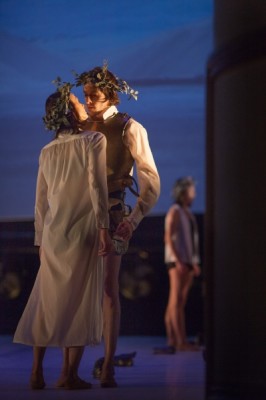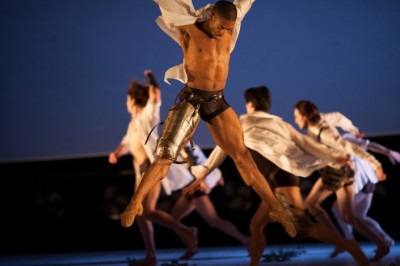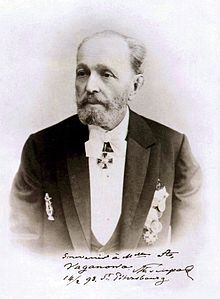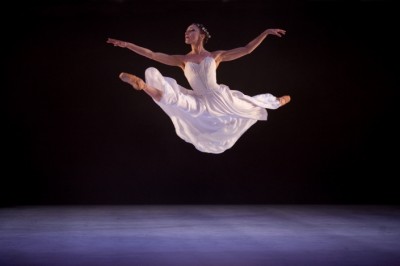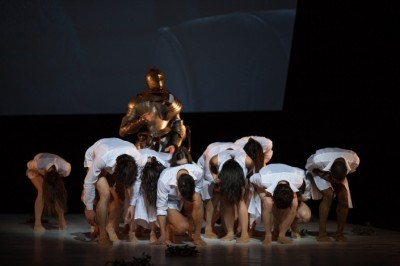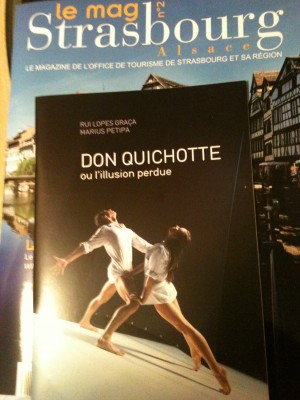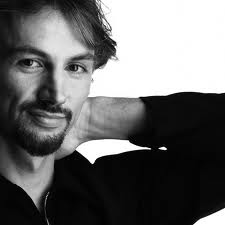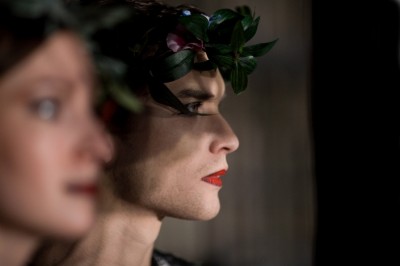Renewed Don Quixote at Opera du Rhin
STRASBOURG: The famouse novel by Cervantes has inspired many forms of performance writers in man ways, well known is the musical The Man of La Mancha, and of corse the famouse ballet Don Quixote with choreography by Marius Petipa, and later by Rudolf Nureyev.
Review by Henning Høholt
It is on basic of this ballet idea i am visiting Strasbourg, to write about how Rui Lopez Graca has managed to solve his production of Don Quixote and the impossible dream. (Don quixote ou l’illusion perdue).
The idea is presented very well in the well formed and good programme, where Graca is explaining all his good ideas and background for why he has made the production as it is being presented. Mentioning the litterature dimension, the love, and the justice.
However, it is a new version of Don Q, we are attending. It opens with a large nearly empty stage, where the only thing presented is the details of the armor of Don Q.
Immediately when the music starts, we are being told through the tune The Impossible Dream sung by Elvis Presley, from the musical Man of La Mancha by Mitch Leigh, that we are in a contemporary world.
The stage is being filled up with many young handsome and well trained dancers, which all has the esthetic dimension, that each of them are either Don Quixote for the male, and the female Dulcinea. All of them find each their piece from the armour, handed them from Sancho Panza, that they put on. It looks like they are all dreaming. They are all dancing and moving in a contemporary dance language by mr. Garca, which works well in this condition, interesting movements, well coordinated, and strange, it fits well to the old music, very well choosen from the same periode when Cervantes lived. Composers Matthew Locke, Heinrich Biber, Henry Purcell, and never Jules Massenet, Antoine Simon, Ricardo Drigo and Eduard Napravnik.
This choice of music function well to the contemporary choreography, which is suiting well in to the movements and atmosphaere in the dance. However, in fact, don’t find any connection to the history
. So if the audience don’t know the Don Quixote history, the choreography can be any contemporary ballet without history.
– but, for me, the history first really starts when we are getting the Ludwig Minkus music from the time when Marius Petipa made the choreography, that we are attending on stage.
The ballet company to the Opera du Rhin has in my oppinnion their strenghts as a contemporary company. As most of the contemporary dancers to day, they are training classical ballet, this company every day, there is not so long a distance between the contemporary movements from mr. Graca. And the classical ballet. They move well in the contemporary movements, and this works well separately.
It is a dream we and Don Quixote together with Sancho Panza on stage are watching, and in that dream many things happen. from the Marius Petipa choreography We were, on Saturday 12th. January pleased to enjoy the solos of The Dryad Queen – Sandra Ehrensperger. Cupido/Amor – Vera Kvarcakova, and Kitri/Dulcinea – Marina Garcia, very well danced, good details.
Furthermore we enjoyed all the Grand Pas de deux where Alexandre Van Hoorde did a good job as Basil together with Kitri. Good cooperation in their dance together and quite well solo parts, spite in that miss Garcia missed her importent fouettes, which she vicely didn’t fulfill. But good expression from both dancers. On Sunday 13th Sandy Delasalle-Scannella was brilliant as the Dryad Queen, and Claire Golluccio as Cupido/Amor
problems?” viagra vs cialis Erectile Dysfunction is a symptom based on the patient’s.
. While Stéphanien Madec-Van Hoorde danced Kitri/Dulcinea and Ramy Tadrous Basile.
As mentioned earlier, these roles are demanding, and very well known in the ballet world and usually always being presented in gallas, on TV and DVDs danced by the worlds famous stars, therefore it is a hard job to doit as well as what the audience are used to. Stéphanien Madec-Van Hoorde did a good job as Kitri/Dulcinea and fulfilled the fouettes. Ramy Tadrous was not so successfull with his parts, but his last solo was good. Both the Basil dancers should work more with their endings of all their parts. Grégoire Daujean look s good as Don Quichotte, and he is well supported by Miao Zong as Sancho. The neutral role as a Dreamer, who also assisted in the Dryade garden as cavallier was by Lateef Williams.
Before that we had a Fandango, choreographed well by Deanna Blacher. Unfortunately, it lacked the spanish temperament, even that the steps and movements were lookin correct, it was not good enough. More expression is needed.
The Orchestra Philharmonique de Strasbourg played very well conducted by Myron Romanul, and i enjoyd many very good soloists in the orchestra. In the first part of the performance where it is a lot baroque music I was happy to enjoy the beautiful sound in the strings. A good harp solo was also noticed in the Petipa/Minkus Don Quixote parts, good worked.
The costumes and scenography made by Bruno de Lavenère worked well, the white shirts in many different lenght very ok. I could have appreciated a few colour spots, and i din´t like the one pair of pink socs on the leading male fandango dancer, tasteless. Lighting worked well by Daniel Worm d´Assumocao.
For me the video by André Godinho, didn´t add anything to the history, and the projection was a bit too pale.
The new balletchief Ivan Cavallari wants his company to continue relating contemporary dance to classical ballet, and in that building a bridge between, – as in this case, Rui Lopez Graca and Marius Petipa, who made the very first Don Quixote. To make this combination and by that changing the company in to a more classical company? It is heartly welcome, as I must admit that thiereis a demand in the daily performance world not to forget the classical basic, as to my opponnion, too many smaller companies are contemporary, and unfortunately, the audience need the romantisism, that we find in the classical ballet. A combination in the repertoire between contemporary and class ical ballet is welcome.
As far as i understand Mr. Cavallaris wish by this, his first production in the house, to perform classical highlights from Don Quixote in combination with the contemporary dreams around it was successfull, it was also ok to put it in to a contemporary frame. However to me, it was not completely successfull. But i notice good signals for the future, and are especially looking forward to how the company will succeed with the coming Peer Gynt ballet. Who is not in advance locked in to a classical language, but still it is demanding if they want to tell the Peer Gynt history by Henrik Ibsen. To the original music by Edvard Grieg
.
The Ballet of the Opéra national du Rhin is one of the rare French companies to move seamlessly from baroque to modern and from classical to contemporary styles, so that every mode of dance can be appreciated to the full. The long list of choreographers from August Bournonville to Jo Strømgren, not forgetting Balanchine, Kylián, Béjart, Forsythe and Lucinda Childs, merely serves to illustrate this illustrious journey. Its repertoire also includes classic ballets such as La Sylphide and Giselle and re-interpretations of iconic masterpieces such as Romeo and Juliet, Swan Lake, The Nutcracker Suite and Coppelia, which act as landmarks for the great 20th-century choreographers, and creations solicited of both young choreographers and seasoned artists.
Their missions: evoking pleasure and emotion
As a national choreography centre (CCN) since 1985 and a national repertory company, the Ballet of the Opéra national du Rhin aims to bring the public a choreographic culture which is often lacking today. It presents a number of landmark works in the repertoire using dynamic, contemporary ways of transmitting its art, and also upholds a dynamic creative policy. The company wants to illustrate the variety and wealth of dance as an essential art form of inexhaustible vitality.

